
The Colonel John Ashley House is a historic house museum at 117 Cooper Hill Road in Sheffield, Massachusetts. Built in 1735 by a prominent local leader, it is one of the oldest houses in southern Berkshire County. The museum is owned and operated by The Trustees of Reservations, and is listed on the National Register of Historic Places.

The Oliver Ellsworth Homestead, also known as Elmwood, is a historic house museum at 788 Palisado Avenue in Windsor, Connecticut. Built in 1781, it was the home of the American lawyer and politician Oliver Ellsworth until his death in 1807, and was designated a National Historic Landmark because of this association. A Founding Father of the United States, Ellsworth (1745–1807) helped draft the United States Constitution, served as the third Chief Justice of the United States, and was a United States senator from Connecticut. The house is owned and maintained and operated as a museum by the Connecticut Daughters of the American Revolution, and is open for tours upon request.

The Ezekiel Kelsey House is a historic house at 429 Beckley Road in Berlin, Connecticut. Built about 1760, it is a well-preserved example of a saltbox colonial residence. It was listed on the National Register of Historic Places in 1977.
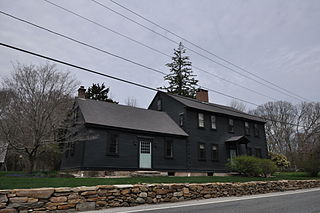
The Mount Vernon Tavern, also known as the Bank House Tavern, is an historic house in Foster, Rhode Island. It is located at 199 Plainfield Pike, about 3/10 of a mile east of its junction with Howard Hill Road. The main block of the house, a 2+1⁄2-story wood-frame structure with gable roof, was built c. 1760, and was originally attached to an even older structure which was demolished in the late 19th century. This main block, five bays wide with a central chimney, is attached to a 1+1⁄2-story gable-roofed ell to the west. The main entrance portico features unusually elaborate Federal styling for a rural location, and was probably added in 1814. The house has long been a landmark on the road, serving as a stagecoach stop on what was the main road between Providence and points in Connecticut.

The Waterman Tavern is a historic house and tavern at 486 Maple Valley Road, near Whaley's Hollow in Coventry, Rhode Island. The 2+1⁄2-story wood-frame house was built before 1747 by John Waterman, who was licensed to operate a tavern on the premises in that year. It is five bays wide with a central chimney. The site was advantageously located on the main road between Providence and Plainfield, Connecticut. The tavern was a center of civic discourse, and town meetings were regularly held there until 1835.

The Dorrance Inn, also known as the Samuel Dorrance House, is a historic former inn at 748 Plainfield Pike in Sterling, Connecticut built about 1722. It is notable as a place that hosted officers of the French Army in 1781 and 1782, as it was along the march route taken by French commander Rochambeau's troops on their march to meet the Continental Army under General George Washington. Dorrance's Inn is one of a few places mentioned by name in multiple accounts written by French officers. The building was listed on the National Register of Historic Places in 2002 and is a contributing building in the Sterling Hill Historic District.

The David Lambert House is a historic house museum at 150 Danbury Road in Wilton, Connecticut. Built about 1726 by one of the town's early settlers, it is a well-preserved colonial-era house with later Federal and Colonial Revival alterations. It is now owned by the local historical society. It was listed on the National Register of Historic Places in 1992.

The Caleb Baldwin Tavern is a historic house at 32 Main Street in the Newtown Borough Historic District in Newtown, Connecticut, built around 1763. The two-and-a-half-story house is considered historically significant for its role in movement of French Army forces under General Rochambeau, as it housed some of the army's officers in June 1781 on their march to the Siege of Yorktown. It is also an example of traditional 18th-century New England architecture and retains some details from that time period. It was listed on the National Register of Historic Places on August 23, 2002.
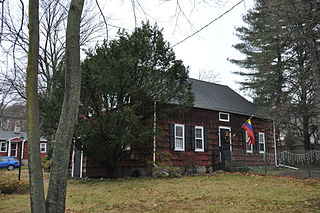
The Samuel Ferris House is a historic house at 1 Cary Road in Greenwich, Connecticut. Built around 1760 and enlarged around 1800, it is a well-preserved example of a Colonial period Cape, a rare survivor of the form to still stand facing the Boston Post Road in the town. It is also locally significant for its connections to the Ferris family, early settlers of the area. The house was listed on the U.S. National Register of Historic Places in 1989.

The Daniel Basset House is a historic house at 1024 Monroe Turnpike in Monroe, Connecticut, built in 1775. It is significant for its association with events in the American Revolutionary War. It is documented to have hosted a ball for French officers of Lauzun's Legion on June 30, 1781; the legion had been encamped near the village center of Monroe. The house was listed on the National Register of Historic Places in 2002.

The John Glover House is a historic house at 53 Echo Valley Road in Newtown, Connecticut, USA. Built about 1708 by an early town settler, it is a remarkably well-preserved example of 18th-century residential architecture, owned for generations by a locally prominent farming family. The house was listed on the National Register of Historic Places in 2001.

White's Tavern is a historic former tavern on United States Route 6 in Andover, Connecticut, built in 1773. It is a well-preserved example of colonial architecture, notable for hosting French Army officers in the American Revolutionary War. It is now a private residence and was listed on the National Register of Historic Places in 1991.

The Josiah Bronson House is a historic house on Breakneck Hill Road in Middlebury, Connecticut, built about 1738. It is one of the town's few surviving 18th-century houses, and a good example of residential architecture from that period. It was listed on the National Register of Historic Places in 1982.
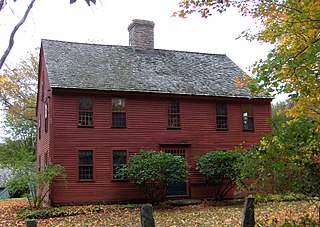
The Oliver White Tavern is a historic former tavern at 2 Brandy Street in Bolton, Connecticut. Built approximately 1750 as a residence, it is a good example of Georgian architecture. The tavern is historically significant because of its association with the march of Rochambeau's army during the American Revolutionary War, on their way to the Battle of Yorktown. The building, now a private residence, was listed on the National Register of Historic Places in 2002.
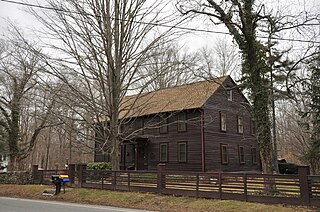
The Eleazer Williams House is a historic house in Mansfield Center, Connecticut, United States. It is located on Storrs Road near the southeast corner of the junction with Dodd Road. Completed in 1710, it was the home of the town's first minister and has a well-preserved chronology of alteration, illustrating changing building practices over the 18th century. The house was listed on the National Register of Historic Places in 1971 and is included within the Mansfield Center Historic District.

The Jabez Bacon House is a historic house on Hollow Road in Woodbury, Connecticut. Built in 1760 for a prominent regional merchant, it is a well-preserved example of Georgian architecture. It was listed on the National Register of Historic Places in 1971.
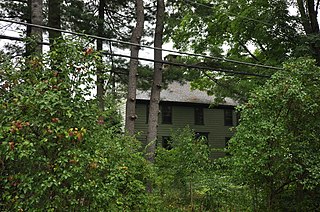
The Holabird House is a historic house on Kellog Road in Canaan, Connecticut. Built about 1740, it is one of the town's oldest surviving buildings, and a well-preserved example of Georgian architecture. It was listed on the National Register of Historic Places in 1982.

The Caleb Martin House is a historic house at 42 Mill Pond Road in Bethlehem, Connecticut. With its oldest portion dating to 1730, it is one of the community's oldest buildings, exhibiting a wealth of construction detail through its 18th-century transformation from a small single-pile house to a full saltbox. It was listed on the National Register of Historic Places in 1996.

130 Hayden Station Road is an unusual Colonial-era brick cottage in Windsor, Connecticut. Built in 1760 next to the Capt. Nathaniel Hayden House, it was probably built as a shoemaker's shop. It was listed on the National Register of Historic Places in 1988.

The Gridley-Parson-Staples House is a historic house museum at 1554 Farmington Avenue in Farmington, Connecticut. Probably built about 1760, it is the oldest surviving house in northwestern Farmington, and a fine example of 18th century Georgian architecture. It is now home to the Farmington Historical Society, and was listed on the National Register of Historic Places in 1981.






















